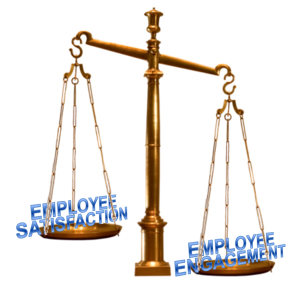Creating an engaged workforce where employees bring all their skill, talent, passion and energy to work every day isn’t rocket science. It doesn’t involve brain surgery. And you don’t need a Ph.D. in human resources development.
Which leads to the question, if employee engagement is so simple, why do so many companies struggle to get it?
Employee engagement works like a light switch. As the leader of your organization, you turn it on by the things you do. You can turn it off just as easily by the things you don’t do.
A few years ago, I wrote a tongue-in-cheek blog about how to suck at leadership. My goal was to point out in a humorous way some of the things leaders and managers do and don’t do that turn the lights out on making employees feel wanted, appreciated and engaged.
For example, all employees crave feedback on their job performance. One way to suck at employee engagement is to avoid holding regular one-to-ones with your direct reports. Or worse, build expectations by scheduling the one-to-ones, then cancel them at the last minute. (Be sure to give a bogus excuse that your direct report knows isn’t true!)
Other ways to suck at employee engagement include:
- Shutting down new ideas. Encourage people to bring up new ideas by saying things like, “That’s the dumbest idea I’ve ever heard.” Or, “What planet do you live on?!” Be sure to do it publicly, so everyone can see how you “reward” employees who dare to offer new ideas and different perspectives.
- Surprising people at performance review time. Start by withholding all ongoing feedback, assuming employees will automatically know how they are doing. Then hold them accountable at the annual review for things you never mentioned before. Employees love that one.
- Failing to define winning. Or, tell people once what winning looks like for your organization, then never mention it again, expecting everyone to remember it with clarity and passion. At the end of the year, punish or fire people for failing to the goals and objectives you never checked in on.
I think you get the point. Most leaders don’t do these things on purpose. But they happen far more often than they should, for many reasons. Either leaders don’t understand the importance of employee engagement. They don’t make it a priority, thinking it will magically happen by itself. Or, their thought bubbles get in the way:
- I’m not good at touchy-feely stuff.
- We’re not paying people to feel engaged; they should just do their jobs.
- Taking time to engage employees will slow down the organization. We’re too busy for that!
- What’s the use since everyone changes jobs so often these days?
In reality, nothing could be farther from the truth. An engaged workforce with the right tools, training and knowledge can accomplish just about anything. We see it around us in most other sectors: sports, music, military…
The Basics of Employee Engagement
A quick Google search will turn up a plethora of information on how to develop employee engagement. Ultimately, it all comes down to creating a culture that supports engagement at every employee touchpoint. How? By providing the things employees want and need to feel engaged.
The top five engagement factors will vary depending on the source, but they typically include things like:
- Trust in management
- Stimulating work
- Skill building/career development opportunities
- Ongoing performance feedback
- Recognition and rewards
To these, I would add:
- Clearly define what winning looks like. If employees don’t know what they’re working toward, they have nothing to engage with.
- Constantly communicate your vision of winning to all levels of the organization. You live and breathe the vision and goals, while most employees are focused only on their day to day tasks. They need to be reminded on a regular basis where the organization is going and what it will look like when you get there.
- Measure what matters and what employees can relate to. Most employees don’t connect with financial metrics like net profit, operating margins and EBITDA. They are important measures, so in addition to these, measure and communicate metrics such as reducing scrap, speeding up delivery times, improving customer retention or developing a new product.
- Act with integrity. Define and clarify the organizational values that determine how people will behave internally and externally. Then live those values on a daily basis. Do what you say and make sure everyone else does.
- Communicate the “why” as well as the “what”. Let employees know why decisions are being made, especially those that directly affect how they do their jobs. Measure both what gets done as well as how people achieve goals.
In addition, keep the information flowing. In today’s social-media world, secrecy breeds suspicion. When you withhold information, people think you have something to hide. So keep employees up to date on how the business is doing and where you see it headed in the next couple of years. Provide regular updates on markets, competitors and other external factors, and when things change, explain why the organization will still win.
Measuring Employee Engagement
Because employee engage involves a combination of job- and culture-related factors, I’m including two checklists for measuring employee engagement.
Job-Related Checklist
This type of checklist can be measured by leader and manager observations, conversations with employees, and employee performance.
Employees at all levels of the organization:
- Can articulate the organization’s vision of winning
- Know the organization’s top three strategic goals
- Understand how their individual roles support achieving the goals
- Know what is expected of them on the job
- Have the tools, materials and skills to excel at their jobs
- Receive regular feedback on their job performance
- Are recognized and rewarded for their performance
- Are provided with opportunities for learning and career development
- Know where to go for help in solving problems
- Look for and act on ways to improve work systems and processes
Culture-Related Checklist
This type of checklist is best measured by confidential employee surveys.
Employees at all levels of the organization:
- Are comfortable bringing up new ideas in meetings
- Feel safe in questioning or pushing back against the status quo
- Enjoy referring talented friends and colleagues as potential employees
- Are convinced they have the opportunity to do what they do best every day
- Believe their supervisor cares about them as a person
- Support the mission and purpose of the organization
- Feel like they have opportunities to grow and develop
- Feel like their opinions are valued
- Believe their fellow employees are committed to doing quality work
Keep in mind that employee engagement can’t be approached as a quick fix or “flavor of the month” management fad. Rather, it needs to become an integral part of your company’s values and operating processes. Make it a top priority for managers at every level, give employees what they need to feel engaged, and measure engagement on a regular basis. As it is with any elite team, you’ll find it’s much easier to reach your destination with a dedicated and engaged workforce.









